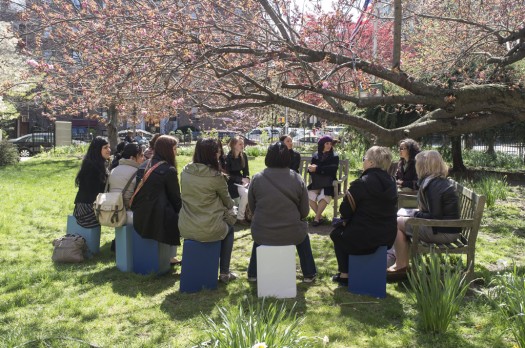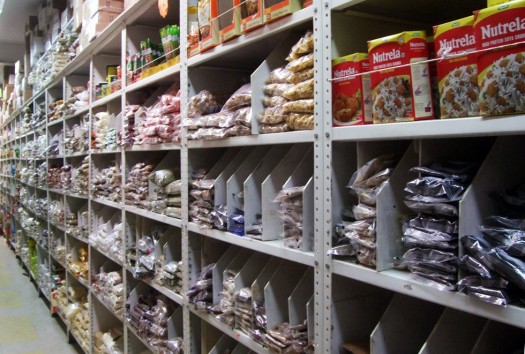
We are celebrating 15 years — and counting — of stories that are deeply researched and deeply felt, that build a historical record of what the city has been.
We are celebrating 15 years — and counting — of stories that are deeply researched and deeply felt, that build a historical record of what the city has been.
Stillspotting nyc is a two-year multidisciplinary project organized by the Guggenheim Museum’s Architecture and Urban Studies department that is making its way to each of the city’s five boroughs (read our review of the second installment here – Ed.). On the weekends between April 14th and May 6th, the third iteration of the project, entitled Transhistoria, is in Jackson Heights, Queens. This past Saturday, I had the pleasure of participating on a warm and sunny afternoon.
Stillspotting is a generous and open-ended project responding to the question of how residents and visitors alike can “escape, find respite, and make peace with their space in [a] ‘city that never sleeps’.” The question seems especially relevant for a place like Jackson Heights; designed as an early 20th century solution to the dense overcrowding of Manhattan, this “garden community” is now one of the most densely populated and culturally diverse neighborhoods in the United States. For Transhistoria, the Guggenheim asked the architects at Solid Objectives – Idenburg Liu (SO-IL) to take this diversity as a point of departure.

Installation views: stillspotting nyc: Queens, Transhistoria | Photos by Kristopher McKay, © The Solomon R. Guggenheim Foundation, New York
The two-hour self-guided walking tour that SO-IL design is punctuated by informal gatherings at different “stillspots” between Roosevelt Avenue and Northern Boulevard where original works of prose and poetry commissioned by SO-IL are read by volunteers and discussed by all. The architects have selected a group of Queens-affiliated artists worthy of attention, including renowned poets Roger Sedarat and Maria Terrone; Chaplain William Alan Briceland; writers Erik Baard, Premilla Nadasen, René Georg Vasicek, and Nicole Steinberg; and rappers of the group Das Racist, Ashok Kondabolu and Himanshu Suri (who is also a community organizer with Seva NY). All of these current or one time Queens residents, many of whom have roots elsewhere, were asked to develop stories about “personal transition, voyage and transformation,” reflecting on how they “achieve a sense of home and familiarity” in their adopted or native borough. The results are consistently engaging, humorous, poignant and, perhaps most importantly, carefully tuned to be enjoyed aloud.
The sites are as gratifyingly diverse and surprising as the texts with which they have been paired: the roof of the Jackson Heights Jewish Center, a quiet living room on the first floor of a residential midrise, upstairs next to the elevated stage at Terraza 7 Cafe, the garden at St. Mark’s Episcopal Church, and at least as many more that I was unable to visit. All of these residential, commercial and public spaces are tied together by SO-IL’s elegant and subtle design intervention: a set of blue foam core stools arranged for stillspotters to gather. The furniture does not create or frame its site so much as merely mark it — encouraging physical restfulness, but also perceptual alertness to one’s surroundings. In the garden at St. Mark’s, a massive cherry blossom tree offered sanctuary enough from the bustle of the street while shedding thousands of its pale pink petals with every gust of wind. Here, on a carpet of discarded leaves, a volunteer read Maria Terrone’s reflection on the therapeutic and transformative effects of learning to cook Indian food from her neighbor, experimenting with a whole new set of ingredients than those tried and tested by her Italian upbringing. The resulting sensory experience was profoundly beautiful and peaceful, and it certainly offered stillness amid what Maria Terrone describes as the “choreographed chaos” of the street nearby.

Installation view: stillspotting nyc: Queens, Transhistoria | Photo by Kristopher McKay, © The Solomon R. Guggenheim Foundation, New York
Perhaps the most memorable aspects of this storytelling tour were not spots or stories at all, but the places and experiences in between. There was the elderly man eloquently arguing his way out of a parking ticket on 37th Avenue in at least two languages, the conversation I had with three excited women celebrating the grand opening of their Colombian Cultural center that afternoon, and the 35 glorious minutes I spent shopping and negotiating the crammed aisles in the Patel Brothers grocery store on 74th Street. Stillspotting turns you into a tourist in the best possible sense: by offering a map with places to visit and encouraging genuine curiosity and mindfulness of your surroundings, you’re likely to discover more than what is advertised.
When you checkout at Patel Brothers, you need to give in to the confusion that ensues from the cashier’s ringing up multiple customers at once — they start the next customer while the machine is processing your card (it’s very slow). Maybe a different cashier gives you a receipt from behind while the first one weighs bulk goods and a third is bagging your stuff. It’s “choreographed chaos” made tangible and one of the many takeaways Stillspotting: Transhistoria has to offer. Another is the papaya I managed to extricate from the produce aisle.
stillspotting nyc: queens
Transhistoria by Solid Objectives – Idenburg Liu (SO – IL)
April 14-15, April 21-22, April 28-29, May 5-6, 2012
More information here.

Patel Brothers Grocery Store on 74th Street Jackson Heights | Photo by Flickr user Lulun & Kame
Gabriel Silberblatt is an assistant editor at The Architectural League and Urban Omnibus, living in Crown Heights, Brooklyn. Follow him @GPS_NYC.
The views expressed here are those of the author only and do not reflect the position of Urban Omnibus editorial staff or the Architectural League of New York.
The views expressed here are those of the authors only and do not reflect the position of The Architectural League of New York.